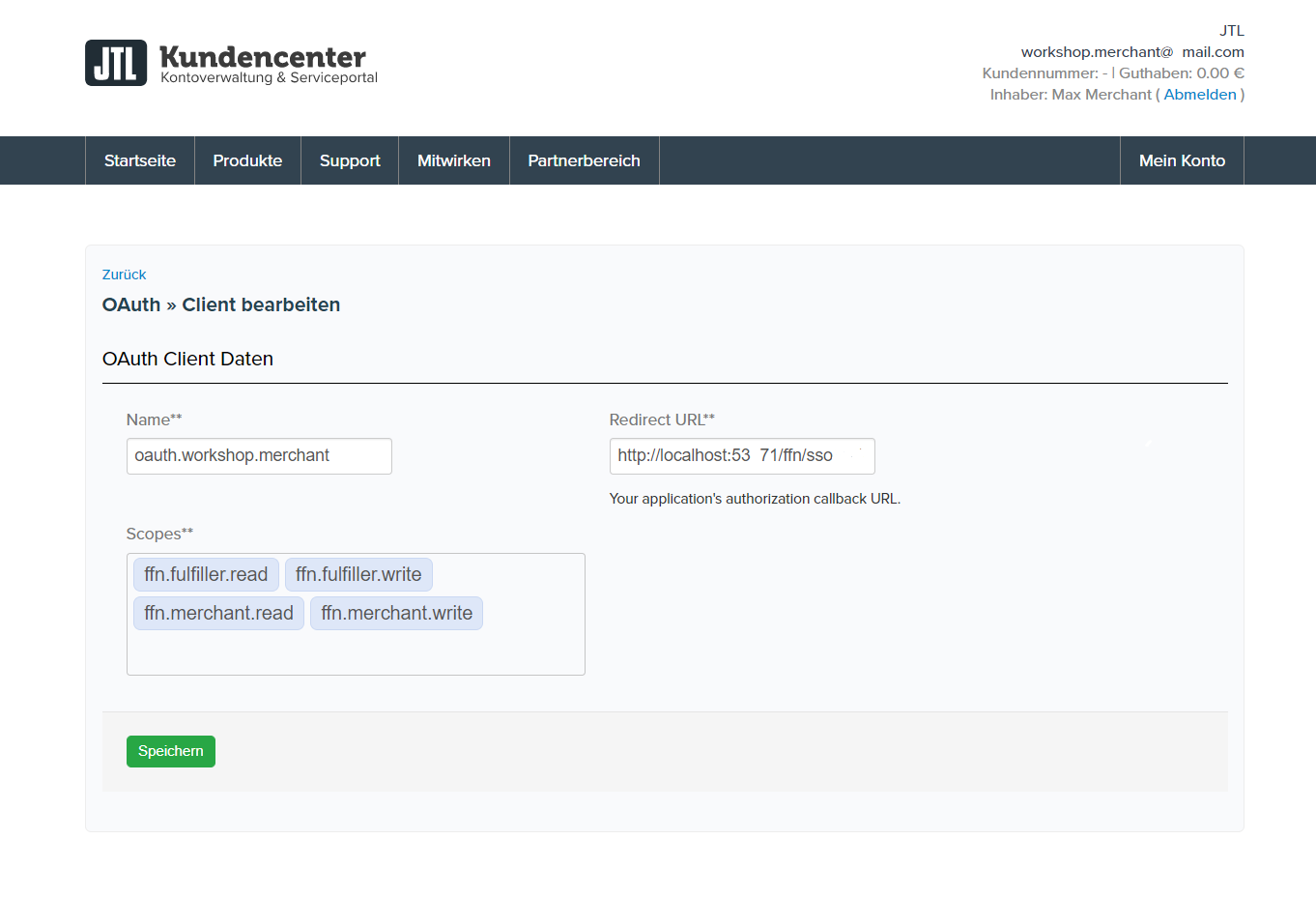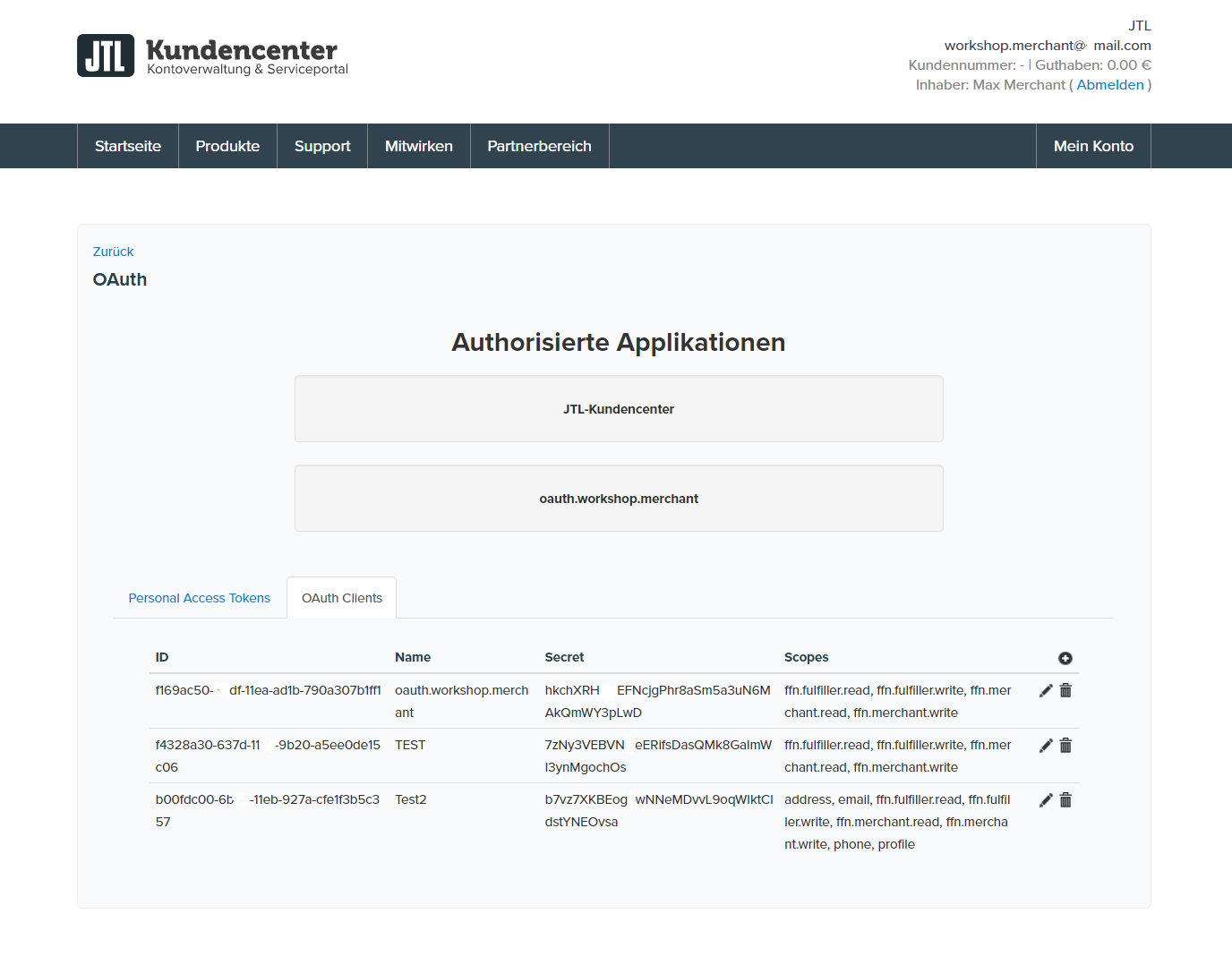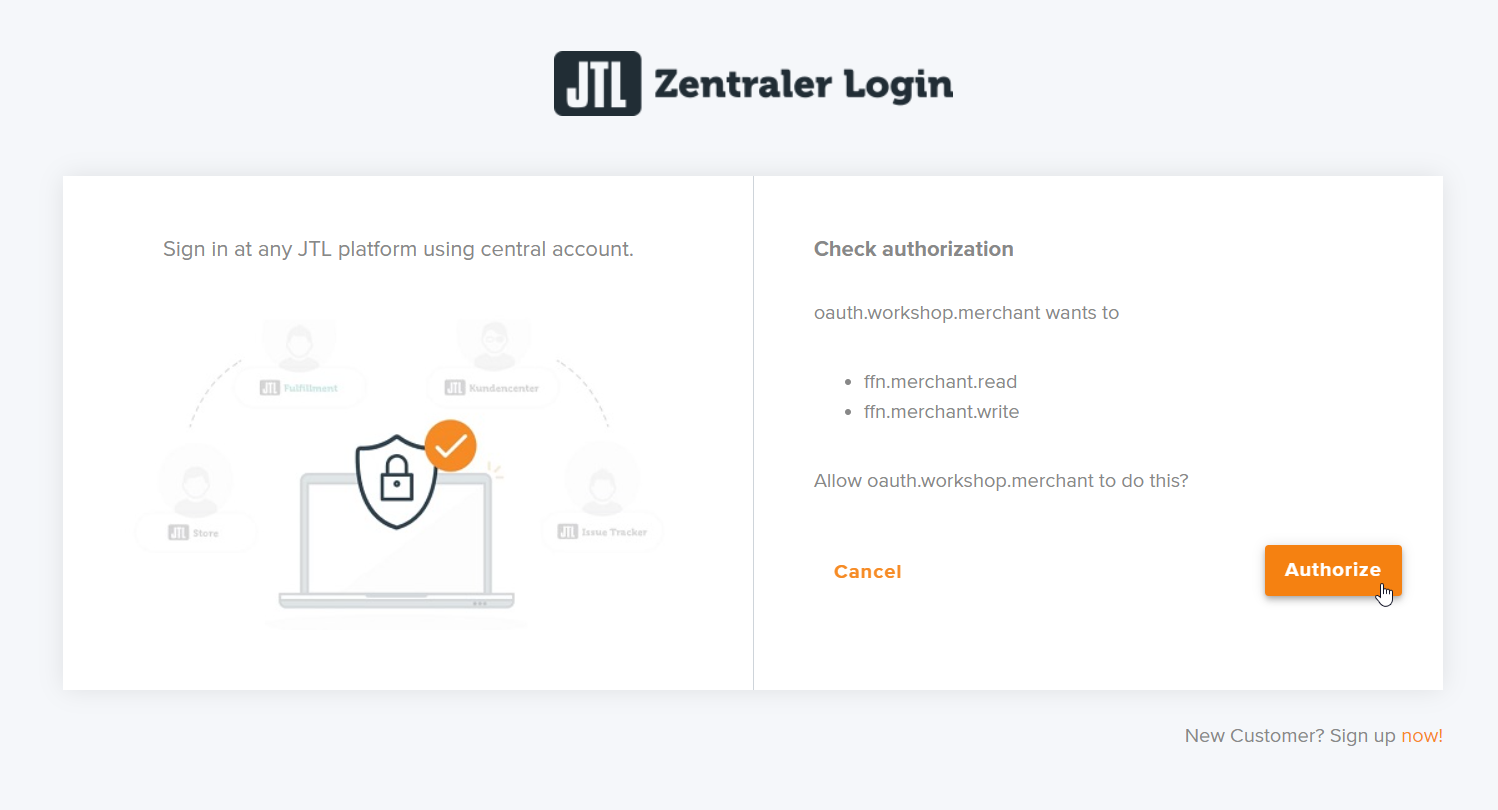OAuth
The FFN-API uses OAuth2 with the Authorization Code Grant for its endpoints. Users must have an active JTL customer center account to authorize against the OAuth2 server.
Client credentials can be created here.
Application credentials
When making calls against the API, you need to do it in the context of an application. You will get the credentials for your application from JTL.
Application credentials consist of the following:
client_id- uniquely identifies your applicationclient_secret- secret used to authenticate your applicationcallback_uri- the uri the OAuth2 server redirect to on authorization requests
Requesting authorization
When you want to authorize a user you redirect him to
https://oauth2.api.jtl-software.com/authorize
with the following query string parameters:
response_type- Must be set to "code" for the Authorization Code Grant.redirect_uri- After the user accepts your authorization request this is the url that will be redirected to. It must match thecallback_uriin your client credentials.client_id- Your applications identifier from your application credentials.scope- The scopes you wish to authorize (space delimited).state- An opaque value that will be included when redirecting back after the user accepts the authorisation. This is not required, but is important for security considerations.
After successful authorization by the user, the OAuth2 server will redirect back to your applications callback with the following query string parameters:
code- The authorization code.state- The state parameter that was sent in the request.
Verifying authorization
The authorization code you acquired in the last step will now be exchanged for an access token. In order to do this you need to POST a request to https://oauth2.api.jtl-software.com/token.
POST https://oauth2.api.jtl-software.com/token
Authorization: Basic
application_basic_auth
Content-Type: application/x-www-form-urlencodedgrant_type=authorization_code&code=
code&redirect_uri=redirect_uri
In the Authorization header Basic HTTP authentication is used. Your application credentials client_id will be used as the username and your client_secret as the password. The header should have the value "Basic" plus the Base64 encoded string comprising of client_id:client_secret.
The body of the request consist of the form encoded parameters:
grant_type- Must be set to "authorization_code".code- The authorization code received from the previous step.redirect_uri- Must match thecallback_uriin your client credentials.
A successful verification request will return a JSON response with the properties:
token_type- is always "Bearer"expires_in- the time in seconds until the access token will expireaccess_token- the access token used for API requestsrefresh_token- token used to get a new access_token without needing to ask the user again
Now the APIs endpoints that need authorization can be called by setting the header
Authorization: Bearer
access_token
Refreshing authorization
To get a new access_token (for example when the old one expired) one can POST a request to https://oauth2.api.jtl-software.com/token.
POST https://oauth2.api.jtl-software.com/token
Authorization: Basic
application_basic_auth
Content-Type: application/x-www-form-urlencodedgrant_type=refresh_token&refresh_token=
refresh_token
The Basic HTTP Authorization works exactly as in the verification step.
The body of the request consist of the form encoded parameters:
grant_type- Must be set to "refresh_token".refresh_token- Therefresh_tokenyou acquired during verification.
The response will be the same as in the verification step.
Scopes
Scopes allow fine grained control over what actions are allowed for a given application. During login users must approve the requested scopes, so it is often feasible to limit asking for permissions your application really needs.
Global scopes for common permission scenarios are the following:
ffn.fulfiller.read- full read access for the fulfiller APIffn.fulfiller.write- full write access for the fulfiller APIffn.merchant.read- full read access for the merchant APIffn.merchant.write- full write access for the merchant API
More fine grained scopes can be acquired from each respective endpoints documentation.
Example
Prerequsites
- JTL Customer center account (https://kundencenter.jtl-software.de/)
- cUrl (https://curl.se/)
- FFN portal account (just login here: https://fulfillment.jtl-software.com)
- FFN portal sandbox account (if you want to test on sandbox: https://fulfillment-sandbox.jtl-software.com)
- Oauth Client for authorization and define scopes
Values in this example (access_token, refresh_token, code...) are expired and cannot be used verbatim.
Step 1 - Create an OAuth client
Navigate to https://kundencenter.jtl-software.de/oauth and create a new OAuth client. (You can´t navigate to Oauth in customer account, you should use this link, or you can change logged in index to oauth)
!Templates define what scopes are possible for this client.
scopes with access rights:
- ffn.merchant.read - full read access for the fulfiller API
- ffn.merchant.write - full write access for the fulfiller API
- ffn.fulfiller.read - full read access for the merchant API
- ffn.fulfiller.write - full write access for the merchant API
More fine grained scopes can be acquired from each respective endpoints documentation.

Overview: clients, scopes, client-secret and client-id

In our example:
- client_id: 97170e65-d390-4633-ba46-d6ghef8222de
- client_secret: f364ldUw3wGJFGn3JXE2NpGdCvUSMlmK72gsYg1z
- redirect_uri: http://localhost:53972/ffn/sso
The values for this client should not be used in production and are for testing only.
Step 2 - User login
In this step you will redirect the user to the JTL OAuth website using his default browser. Here the user will provide his username/password and accept the requested scopes. Finally the JTL Oauth website will redirect to the provided redirect_uri and provide the code.
Template: authorize specified scopes and get code answer to request the access token
https://oauth2.api.jtl-software.com/authorize?response_type=code&redirect_uri=[redirect_uri]&client_id=[client_id]&scope=[scopes]
Note: the scopes should be seperated by spaces or %20
Filled with our example values:
https://oauth2.api.jtl-software.com/authorize?response_type=code&redirect_uri=http://localhost:53972/ffn/sso/oauth&client_id=97170e65-d390-4633-ba46-d6ghef8222de&scope=ffn.merchant.read%20ffn.merchant.write
- enter password

- authorize scopes

- code answer from server

Example of the answer from the OAuth server to our redirect_uri:
http://localhost:53972/ffn/sso?code=def50200f3ac7aabbb6e82a6b131874115b858549dab62e73c68ea21a03de59b5744dc0f0ee321d7607062cf9bfa57471cd0ee7572db1d7b0a15779b0dda7d0ed8f8bfdb0f69939a34678d67aee41e4849d355d8aa223733ab1f397280b205fa739c6252d77d9ff600136e1b744352115fd62ba1035d8da4cbc1b6791c61d0bb621952b0a14625dd75807113ea0746e35528c304a8ce3c06724c1e1d9e1cb3709e9f52778bc8ca5b2d8f7c055f14244b1f8fcb61554c5bf48e02b882b87b9a76a43579eecd578cec97c6f603907e282e45cfec43837c063dc36b556d4974776a942f47cee19023e130ae852bfca6d3ca9c7cb3283d2bc4971f80651b626f8e7ba0ec2d13dddc4c528e1f3e470de907af7eb304d781534dd9b071d9760c9890e5756893c7800589c407bd2da3a2ff56c3fb15a410e24aa2df7ac54e8d0f7445e38e390171b58a0b66b337057d59acd29ed5bbc4df6bee921b244f030c86f49bcae21c9ca77c05eea0094414803f30089c39d585bf83604a2d9bbcc6442fbfdcff6cca946eb84d1eac2e4f98dff31a93460c951c853f9ef7140f572be963e82a3baf72afba34572af63ee7da
Extract the code and note it for next steps.
Step 3 - Get an access_token from the code
Template: get access token + refresh token
curl --location --request POST "https://oauth2.api.jtl-software.com/token"
--header "Content-Type: application/x-www-form-urlencoded"
-u "[client_id]:[client_secret]"
--data-urlencode "grant_type=authorization_code"
--data-urlencode "redirect_uri=[redirect_uri]"
--data-urlencode "code=[code]"
Filled with our example values:
curl --location --request POST "https://oauth2.api.jtl-software.com/token"
--header "Content-Type: application/x-www-form-urlencoded"
-u "97170e64-d390-4696-ba46-d6fcef8207de:f364ldUw3wIJFGn3JXE2NpGdAvUSMlmK72gsYg1z"
--data-urlencode "grant_type=authorization_code"
--data-urlencode "redirect_uri=http://localhost:49420/oauth"
--data-urlencode "code=def50200e6f3c65cfaba9419cbf6e48a7ed4324ef851b0ace493213884496b851fd825b90b4f994ee265a62f2358bbcbb0f990af5dbfd93dc63e51a7a6fa3bcfc7f722f56366b0a726fd1ed5df1cb926b16610fc7beb0f236e8858e86397422e3caa75d8094af8ba8ad6a93b938bd341bec1e4df671ad71ad1d5fa41166f5d4b2a3ac7d9172c35a8501f10ad722ec2aea88439c21b148ec2ba85e93c17acebe7d7f3d0118a50941cab145ed5ce92946426e5d388584556c0b010c567b433c577a1c4f7b1dfb2c99c25a0efadece4f64f19e54305bfc591e2b30b1a7ba1a33af3e039bcfa80b21ca365dc003f07989fca92472c2c8e2daab51151624a6a10bc511f2ed586f06544f7b98566df4667f5bbd6ba7c6707cb673c767c9eab5a74e63a8269688941c3158e8cc1cb5ebe9a8aa468faf415171a481ee1489b58bedb5fc329b23e0e34e76a4a500270fbebe4e1d20a0f17cebc96cd8ab3db383af746ca0699da34b4665afad30e9dde4f5f507a1dd14c73a692f06de8bafe3be81d7744dbcd8c5f7d3c767101ff5ce0556c244130c1c3fc3f53975a841c0cacebb70118f7552f50c2d2b1c421b8a21e"
The result will be a JSON answer with the users access_token and refresh_token as well as the expiry in seconds.
{
"token_type":"Bearer",
"expires_in":1800,
"access_token":"eyJ0eXAiOiJKV1QiLCJhbGciOiJSUzI1NiJ9. eyJhdWQiOiI5NzE3MGU2NC1kMzkwLTQ2OTYtYmE0Ni1kNmZjZWY4MjA3ZGUiLCJqdGkiOiJlOWVhN2Q0MWI1NDIzNTcyYWU0MDEzYjEzMDZiMGRkNWM3YmQ2ZTNjMDNhYTZmNjQ2M2NlMjUzNTc0ZmUyMWE3NGQyNTIyMTJhODQwMmI1ZCIsImlhdCI6MTY2MTI1MzE0OCwibmJmIjoxNjYxMjUzMTQ4LCJleHAiOjE2NjEyNTQ5NDgsInN1YiI6IjQ2MjA5Iiwic2NvcGVzIjpbImZmbi5tZXJjaGFudC5yZWFkIiwiZmZuLm1lcmNoYW50LndyaXRlIl19.eEwY021wR3BWVp-wbAVQrjfqwFbYqLlOV_ca-cb7-O3Kdpi8mkFQBxfI8rzSiV_1WpAINf4ydV9FR9Ty992SMiAqGJ3T9zDHd68oUDePeq7Xfafp-87UboI2mCfGd7518CoKVLqg5ohb4YCqgC7Dz588FofggCQyDZQSM-8raOgcM-pJ1TT7oRuYuDHsOzCOTPcX2YiGYKCc3M6kxlBy_NjrJoLa4qysLRmPkznWwj0caC7a0VJO5KubvECcMb9D7Byr3UNjI7GiGMAufa770V5qCjrWs4gOsRV-Bn7oQydvsL21qqjBKHcssQrlLZWmrcfKqgBKwfRXIx3Mu5HBCmtHjHMnuvPVEZAj6fEfIwjYSeTAHTHApEwbE7J1MPd8MU0K6X2YEUF315fXN5F3rO3ZL5FdTwcM1E-1-PKubLuMAaE6Lw-QsDtBoI4ESylomCmCCfgLV4Vj-in_oCJUmKXAX0tDSa9y9vb6oAExung_BTJCBemffCtkJ55Px7bvi9JXmwvI0pIFo3QzTUtRbFDizCMrPZvsatFx64mXX3IDoVqXr3uzvdetBIJEj2ngVdGRrKGt4Yboae5oFV2d5jdSZBL28pwGjey__ZB4zLR1DodQ0sOqDWJ3WsEjMYXU8_-IGrS8Kkw8Q0R0UqqyVLfcLr-cfH5tYqf2QLqAScY","refresh_token":"def50200e636703f8d6372401e7b5e1163e0f46e5d593f6f8a1e9b1b2777d64684b87b7c552db62f9670bc482a3958d8aafb78083c7166c13f2f233fe4623d22873c819a560dc3213a51448a1e0763c2a0f7fb7230ceeae22a7fa84717458886584ab5a0ed1a500be5f9d3ed36b1d063d39b56c8431f3fe623055626c1f99f8c5b684853965645fe5c5bee941857aef79ae4f9b994316bec9d365119fe0fe8d035218c44d00a47c0e92b4613c1f388b9c171f3d79e45a6d2a52dfbd8d25608d6b0350420155e48cc179764a2432220cc0d1e9bfa7798050d0b36fe658e967186ea75cc1d1277cad973d43a0839c50b6885a87b5b446452855a00ac75c5f6d7f62b914496e30ab89a16b335977e4363b94dda7364bb052832a5d122696b6476fb0e1631030ea3c42d9659ca839cc44919efc9532c84f7170e634d3e189eb181d0c114ed9d8150c619f7567587e0311d89d51d1325646d2c014757ba7f2d7b02f7b56a52e093ed2ea95a8abe4a0289b24a5636dce8ad01c20e8cce8c4c51263e7f1731bb6335b0e31342e2439c77ab7cce7a147e24c9be9d61d8eba216fbfd4d5be2fba3502e69000ad6e67b7230a7f924"
}
Step 4 - Test the access_token
Using your newly aquired access_token you can test if its working (reminder: the access_token has a limited lifetime and might be expired, in which case we would need to refresh it (see Step 5)).
Template: Test communication with access token on sandbox or production (our client is for both systems)
curl --location --request GET "https://ffn-sbx.api.jtl-software.com/api/v1/users/current"
--header "Authorization: Bearer [access_token]"
If you cannot retrieve the user data using this endpoint make sure you have logged into our respective portal website (sandbox, production) at least once as this triggers user creation in the system.
Step 5 - Refresh access_token when it expires
Template: Get a new access token + refresh token with the refresh token
curl --location --request POST "https://oauth2.api.jtl-software.com/token"
--header "Content-Type: application/x-www-form-urlencoded"
-u "[client_id]:[client_secret]"
--data-urlencode "grant_type=refresh_token"
--data-urlencode "refresh_token=[refresh_token]"
Filled with our example values:
curl --location --request POST "https://oauth2.api.jtl-software.com/token"
--header "Content-Type: application/x-www-form-urlencoded"
-u "97170e64-d390-4696-ba46-d6fcef8207de:f364ldUw3wIJFGn3JXE2NpGdAvUSMlmK72gsYg1z"
--data-urlencode "grant_type=refresh_token"
--data-urlencode "refresh_token=def50200a01c0caff50b7db271f8268e3806ab2cce8e28e25f41e5fe9167a6521b47f6ed0dd3dd2d7856e1983ae645b032cf9285e91c1ee535decb0e0ca3e52670773f2737114955267d83db0204f80233214a623fcc36de04127e1cdcda006eaf60cacfb30c80081a8c9314e20117f64639ab5e333301a10173385c1bfc660709fde0b1a3517f8030dfdba8187e53c23c9d5fe9f33c48e11a4aa41bfd9ea1291507ea1bc8c64df32bdc91c61af907c41cf0bb305cae76e68448a85ad65b0a03a23ec35a7e9cc42aadd0792b9d7d187ae028e2759a7f4a0164f94d9baca29779a702f023216631e1e777069cc2bc65fd404f4fcc5818219063beb1717afe159b8110394af9a0d245de960c227b1183d6a745819ac08d92238938da798f702f83a3faf648f07a8a6d1e694c008517fd8be2fa154aab88a3eaacb3cbb1830c4bdee018e06c7f81e68c5844213f1d02372b23a22d99ac06a860748a3db891fd71768d74470c9a5a8571058dd901c888d13cd4481d63a800322614e63d3d8e6fb109ee7e1b1e046cd086ecbc2d4d362ca662e3ac867f21168833abd7a8247b06602197b7da555361efbf07b0afed69f7a558"
The result will be the same format as in step 3. Refresh_tokens are only valid for a single refresh and you will get a new refresh_token every single time that you must persist.
My token is not working!
404 NotFound
You need to log into the respective portal website (sandbox-https://fulfillment-sandbox.jtl-software.com, production-https://fulfillment.jtl-software.com) at least once to trigger user creation.
403 Forbidden
You might be missing scopes in your token and don't have sufficient rights.
401 Forbidden
Incorrect Oauth method. For example, we do not support the Oauth method authorisation "client_credentials grant". The authorisation method "code grant" with user must be used.